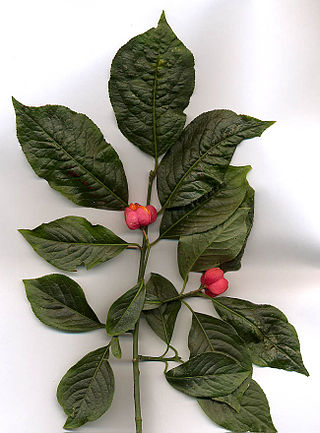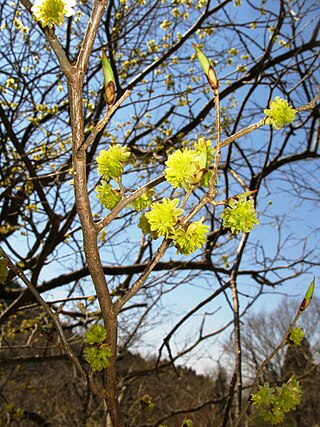
Euonymus is a genus of flowering plants in the staff vine family Celastraceae. Common names vary widely among different species and between different English-speaking countries, but include spindle, burning-bush, strawberry-bush, wahoo, wintercreeper, or simply euonymus. It has about 140 species of deciduous and evergreen shrubs, small trees and lianas. They are mostly native to East Asia, extending to the Himalayas, and they are also distributed in Europe, Australasia, North America, and Madagascar. Fifty species are endemic to China.

Euonymus japonicus is a species of flowering plant in the family Celastraceae, native to Japan and Korea.

Euonymus europaeus, the spindle, European spindle, or common spindle, is a species of flowering plant in the family Celastraceae, native to much of Europe, where it inhabits the edges of forest, hedges and gentle slopes, tending to thrive on nutrient-rich, chalky and salt-poor soils. It is a deciduous shrub or small tree.

Centaurea montana, the perennial cornflower, mountain cornflower, bachelor's button, montane knapweed or mountain bluet, is a species of flowering plant in the family Asteraceae, endemic to Europe. It is widespread and common in the more southerly mountain ranges of Europe, but is rarer in the north. It escapes from gardens readily, and has thereby become established in the British Isles, Scandinavia and North America. This plant has become an invasive species in British Columbia, Canada. Centaurea montana grows in meadows and open woodland in the upper montane and sub-alpine zones, in basic areas. It grows to 30–70 centimetres (12–28 in) tall, and flowers mainly from May to August.

Euonymus alatus, known variously as burning bush, winged euonymus, winged spindle, and winged spindle-tree, is a species of flowering plant in the family Celastraceae, native to central and northern China, Japan, and Korea.

Euonymus fortunei, the spindle, Fortune's spindle, winter creeper or wintercreeper, is a species of flowering plant in the family Celastraceae, native to east Asia, including China, Korea, the Philippines and Japan. E. fortunei is highly invasive and damaging in the United States, causing the death of trees and forest in urban areas.

Euonymus phellomanus is a species of flowering plant in the family Celastraceae, native to China. It is one of several species within Euonymus called spindle or spindle tree. A substantial deciduous shrub growing to 2–4 m (6.6–13.1 ft) tall by 2.5 m (8.2 ft) broad, it produces insignificant yellow-green flowers in May followed by brilliant pink fruits in autumn. The fruits sometimes break open to reveal bright orange seeds. A notable feature is the rough corky bark which with age develops "wings" clothing the length of each branch. A similar effect is seen in the related Euonymus alata. This feature gives rise to a name occasionally used, the corktree.

Euonymus sachalinensis, the flat-stalked spindle, is a species of flowering plant in the family Celastraceae, native to Japan, China, Korea, and the Island of Sakhalin. Growing to 2.5 m (8.2 ft) tall and broad, it is a deciduous shrub notable for its leaves turning red in autumn, and its red fruit which splits open to reveal orange seeds. Exceptional specimens, such as the one in the Hørsholm Arboretum, Copenhagen University, can become trees up to 4 m (13 ft) in height.

Euonymus oxyphyllus, the Korean spindle tree, is a species of flowering plant in the family Celastraceae, native to central and eastern China, Manchuria, Korea, Japan and the Kurils. It is a shrub or small tree typically reaching 2.5 m (8 ft). The Royal Horticultural Society considers it to be a good tree for smaller gardens, especially for its colorful Autumn foliage and fruits.

Indigofera himalayensis, the Himalayan indigo, is a species of flowering plant in the family Fabaceae, native to the western Himalayas. It is a deciduous shrub reaching 1.5 m (5 ft), with a cultivar called 'Silk Road' that is readily available in commerce.

Lindera praecox, the February spicebush, is a species of flowering plant in the family Lauraceae, native to southern China, and Japan. A deciduous shrub typically 4.5 to 7.5 m tall, it is hardy to USDA Zone 8. In the wild it is found in thickets on the slopes of hills and mountains, and on the banks of streams and lakes. It is occasionally available from specialty nurseries.

Deutzia pulchra, the beautiful deutzia, is a species of flowering plant in the family Hydrangeaceae. It is native to Taiwan and the Philippines. A deciduous shrub reaching 2.5 m (8 ft), it is readily available from commercial suppliers.

Cytisus × praecox, the Warminster broom, is an artificial hybrid species of flowering plant in the family Fabaceae. Its parents are Cytisus multiflorus and Cytisus oromediterraneus. A deciduous shrub, it is available from commercial suppliers. It has a number of cultivars, including 'Allgold' and 'Warminster', which have both gained the Royal Horticultural Society's Award of Garden Merit. Other commercially available cultivars are 'Albus' and 'Lilac Lady'.

Rhododendron sinofalconeri, the sinofalconer rhododendron, is a species of flowering plant in the family Ericaceae. It is native to southern Yunnan and northern Vietnam. An evergreen shrub or small tree reaching 3 to 10 m, it is typically found in mixed evergreen/deciduous forests and thickets, at elevations from 1,600 to 2,500 m above sea level. It is available from commercial suppliers, and features trusses of 15 to 20 pale yellow flowers, each 5 cm (2 in) long, and large 30 cm (12 in) leaves.

Euonymus latifolius, the broad-leaved spindle tree, is a species of flowering plant in the family Celastraceae. It is native to the Mediterranean region, south-central Europe, the Caucasus, and the Middle East as far as Iran, and it has been introduced to Ireland, Great Britain, and Belgium. A shrub with a rounded growth form reaching 2.5 to 4 m, it is typically found in shrublands, and in rocky habitats such as inland cliffs and mountain peaks. In the wild, it requires shade; too much sunlight can prove lethal. A low maintenance choice for a number of landscaping and garden applications, it is available from commercial nurseries.
Euonymus aculeatus, the prickly spindle, is a species of flowering plant in the family Celastraceae. It is native to southern China. A scrambling evergreen shrub reaching 2 to 3 m, it is typically found in forests and scrublands from 300 to 1,500 m above sea level. Valued for the visual appeal of its prickly orange fruit, it can be trained to climb up a garden wall, or be used as a ground cover.

Euonymus myrianthus, the many-flowered spindle, is a species of flowering plant in the family Celastraceae. It is native to central and southern China. A variable evergreen shrub or small tree, and reaching 3 to 12 m in height, it is typically found in wooded areas and forests, from near sea level up to 1,200 m (3,900 ft). In cultivation it does not grow much past 4 m (13 ft), and is valued for its profusion of yellow-orange fruit and scarlet arils which remain on the plant and provide winter interest. It is readily available from commercial suppliers.

Euonymus sanguineus, the blood red spindle, is a species of flowering plant in the family Celastraceae. It is native to Nepal, and to nearly all of China except Xinjiang, Manchuria, and Hainan. A deciduous shrub reaching 3 to 5 m, it is typically found in scrublands and mixed evergreen/deciduous forests, at elevations from 1,800 to 3,700 m. It may be available from specialty suppliers.
Euonymus wilsonii, the Chinese euonymus, is a species of flowering plant in the family Celastraceae. It is native to central and southern China. A large, lax shrub typically 3 to 4 m tall, it is found in forests and scrublands at elevations from 1,000 to 2,600 m.

Euonymus nanus, the dwarf spindle tree, is a species of flowering plant in the family Celastraceae. It is native to the Black Sea region, Central Asia, Mongolia, and northern China, and it has been introduced to Germany. A deciduous or semi-evergreen shrub reaching 1 to 2 m, it is adapted to cold, dry conditions, and is typically found in forests and scrublands high in the mountains. Available from commercial suppliers, its leaves are narrow and resemble those of rosemary.




















